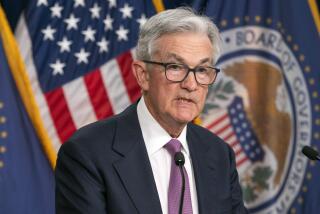Recovery Appears to Be Under Way, Greenspan Says
- Share via
OSAKA, Japan — Federal Reserve Board Chairman Alan Greenspan said Wednesday that recent evidence suggests that the U.S. economy has begun to recover from recession, a prospect that makes unlikely further cuts in interest rates by the central bank to spur growth.
Greenspan’s remarks, though carefully couched, marked his first assertion that a recovery appears to be under way, in contrast to his earlier view that the recession that has gripped the economy since last summer finally may be reaching bottom.
Although the economy is “not yet . . . clearly in an upswing,” Greenspan said, “the data for the last 10 days have shaded the probabilities in the upward direction.
“The probability of a stronger-than-expected recovery is rising slightly,” he said at a press conference here after a closed-door session of the International Monetary Conference, an annual meeting of top commercial bank executives from around the world.
He drew attention in particular to recent signs that new orders are picking up for the nation’s manufacturers, a development that might be reflected in May job figures scheduled to be released Friday.
Although the Fed chief did not say so explicitly, his comments strongly suggest that the central bank will stop trying to stimulate the economy with lower interest rates. The Fed has aggressively sought to combat the recession by easing monetary policy, including a cut several weeks ago in the bellwether discount rate to 5.5% from 6%.
Central bankers around the world have been far more cautious than their political counterparts when it comes to cutting interest rates, out of fear of kicking off a new round of more rapid inflation.
Greenspan’s suggestions of caution on further interest-rate cuts were sharply underscored Wednesday by Japanese and German central bank chiefs who appeared with him at the press conference. They were also quickly reflected in the New York financial markets, where bond prices sagged, leading to weakness in the stock market.
Greenspan said recent statistics indicate that companies have stopped liquidating their inventories--that is, they have stopped the typical recessionary behavior of filling orders by selling old stocks of goods.
The Fed chief said he is not certain that companies have started actually building inventories, as they must do when orders begin increasing in a recovery, but he said that the “mere ending of liquidation suggests we will begin to see” evidence that production and employment are bouncing back in the next few months.
Greenspan did not mention precisely which statistics had impressed him. In the past several days, however, figures have shown that auto sales picked up strength in the latter part of May; factory orders turned up in April after 10 straight monthly drops, and a survey of purchasing managers showed orders rose even more last month.
In his comments, Greenspan also hinted that the Fed is unlikely to drive interest rates higher any time soon because of the favorable outlook for inflation.
The Economy: Productivity Inches Up
Indicator: The productivity of American workers for first three months of 1991.
What it did: Non-farm productivity posted a barely perceptible gain of 0.3% in the January-March period, much worse than first believed, the Labor Department said. The revised increase--much weaker than the 1% gain first reported by the government--is one more piece of evidence about how poor the nation’s economy did in the quarter, analysts said. Total productivity, including farming, inched up a tiny 0.1% for the period.
What it means: Economists say the figures are further evidence of continued stagnation. They say the higher the rate of productivity, the higher the standard of living, the higher the take-home pay. When productivity doesn’t grow, the income of the average American doesn’t grow. The reason for the nation’s slumping productivity performance appears to be a lack of investment and savings.
Highlight: For 1990, non-farm productivity tumbled 0.9%, following a 0.7% decrease in 1989. That was the first back-to-back retreat in productivity in a decade. Before the two-year slide in productivity that began in 1989, the nation had averaged productivity growth of 1.6% a year since 1982, following the end of the last recession.
Productivity Non-farm business productivity, percent change from previous quarter at annual rate, seasonally adjusted. First quarter, 1991 preliminary: +0.3% Source: U.S. Dept. of Labor
More to Read
Inside the business of entertainment
The Wide Shot brings you news, analysis and insights on everything from streaming wars to production — and what it all means for the future.
You may occasionally receive promotional content from the Los Angeles Times.










